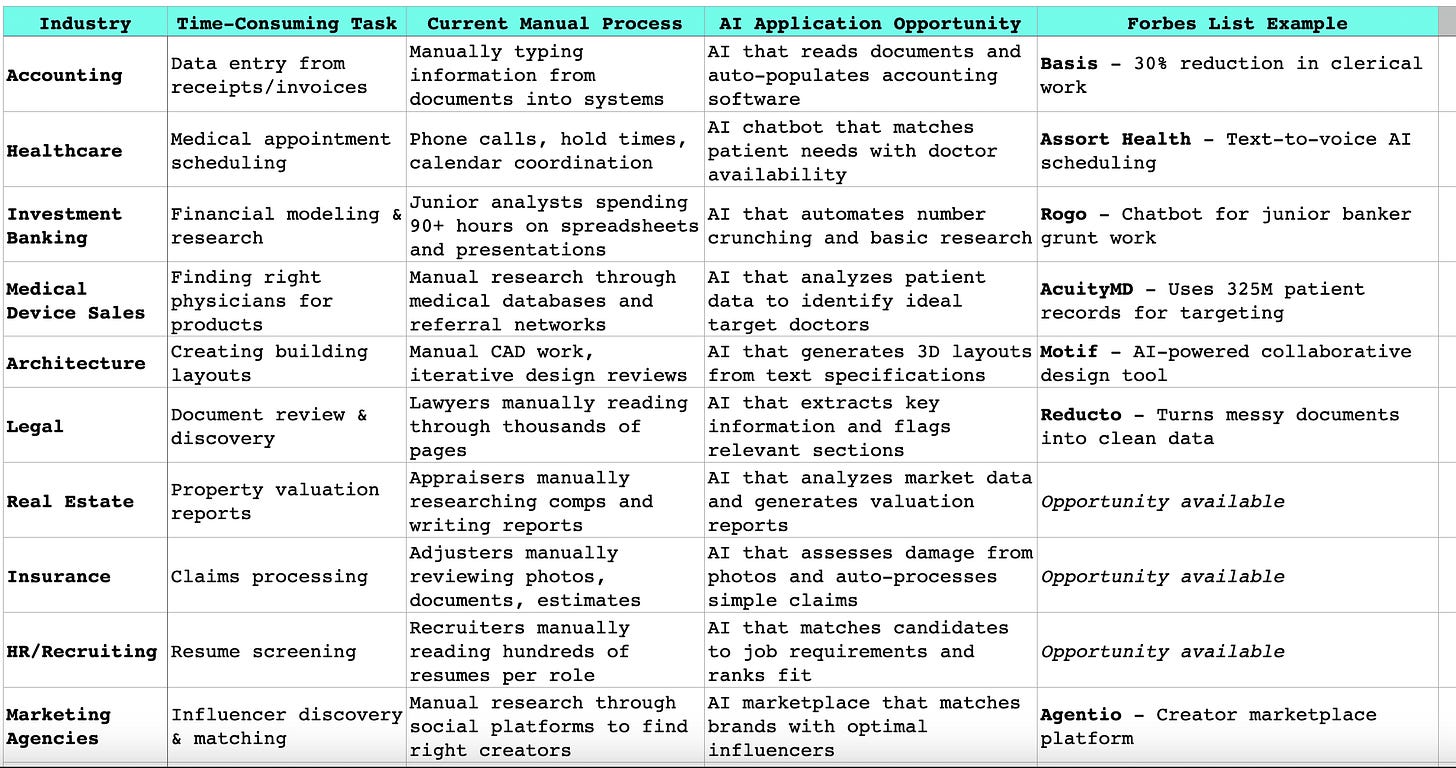The AI Application Layer Just Ate Silicon Valley
Gathering insights and uncovering your opportunity map from Forbes 2025 Next Billion-Dollar Startup list
Here's what Forbes just proved with their 2025 Next Billion-Dollar Startups list:
The biggest AI opportunities aren't in building better models. They are in automating the boring stuff that knowledge workers hate doing.
20 of 25 companies on the list followed the same playbook:
Find time-consuming, repetitive tasks that require information processing
Build AI to do them faster
Watch customers throw money at you for giving them their lives back
The pattern is so clear it's basically a treasure map.
Let me show you where the gold is buried. 👇
High-Volume Information Processing = Instant ROI
Every industry has tasks where humans spend hours reading, analyzing, or transferring information between systems. These are AI's sweet spot because the value proposition is blindingly obvious.
For example:
Basis tackled accounting data entry, taking information from receipts and invoicing documents and moving it into accounting software. Result: 30% time reduction for accounting firms.
Reducto does the same thing for legal document review, turning "messy documents into clean, usable data."
Your opportunity:
Walk through your target industry and ask: "Where do people spend entire days moving information from Point A to Point B?"
That, my friend, is your product.
Real examples ripe for AI disruption:
Real estate: Appraisers manually researching comparable sales and writing valuation reports
Insurance: Claims adjusters reviewing photos, estimates, and documents to process claims
HR: Recruiters reading hundreds of resumes to find qualified candidates
The math is simple. If someone's paying a knowledge worker $50/hour to do data transfer, they'll pay you $20/hour to automate it.
Pattern Recognition at Scale = Competitive Moats
The most valuable AI applications don't just process information. They spot patterns humans would miss or take forever to find.
AcuityMD analyzes de-identified data for 325 million patients to help medical device companies find the right physicians for their products.
Agentio matches brands with optimal influencers by understanding creator audiences and engagement patterns.
The Framework:
Look for industries where success depends on finding the right match from thousands or millions of options. Then build AI that gets better at matching the more data it sees.
Billion-dollar matching opportunities:
Legal: Matching law firms with expert witnesses based on case type and success rates
Construction: Matching contractors with projects based on specialization, capacity, and location
Education: Matching students with tutors based on learning style, subject expertise, and availability
Pro tip:
The best pattern recognition plays get more valuable over time. Every successful match makes your AI smarter, creating a data flywheel that competitors can't replicate.
Repetitive Documentation = Pure Profit
If an industry creates the same type of report, analysis, or summary over and over, there's probably a $100M+ AI opportunity waiting.
Nominal automates the analysis reports that aerospace companies need after testing aircraft and hardware.
Motif generates architectural layouts that would normally require hours of CAD work.
Rogo handles the financial presentations and spreadsheets that burn out junior bankers.
Your documentation audit:
Pick any knowledge-intensive industry. Find the reports that get created weekly or monthly. Ask: "What if AI could generate 80% of this content automatically?"
Untapped documentation goldmines:
Consulting: AI that writes client recommendations based on data analysis and industry best practices
Medical: AI that generates patient summary reports from doctor notes and test results
Marketing: AI that creates campaign performance reports with insights and optimization suggestions
The key insight:
You're not replacing human expertise. You're eliminating the grunt work so experts can focus on strategy and relationships.
Multi-System Data Transfer = Hidden Time Sinks
The biggest productivity drains often happen between software systems.
Someone downloads a report from System A.
Reformats it.
Uploads it to System B.
Repeats daily.
Assort Health eliminated the phone-to-calendar dance in medical scheduling.
Lead Bank streamlined the documentation flow between traditional banking and fintech operations.
Your integration opportunity:
Map the software stack in your target industry. Find where people manually move data between systems. Build AI that connects the dots automatically.
High-impact integration plays:
E-commerce: AI that syncs inventory, pricing, and product data across multiple sales channels
Manufacturing: AI that connects production data with supply chain and quality systems
Professional services: AI that moves project data between CRM, billing, and delivery platforms
Why this works:
Integration problems are expensive enough that customers will pay premium prices, but boring enough that big software companies ignore them.
Time-Sensitive Matching = Urgent Value
The most profitable AI applications solve problems where speed creates significant value or avoids major costs.
LiveKit handles real-time audio/video processing for 25% of 911 calls—where seconds matter.
Rox automates sales research and outreach so reps can focus on closing instead of prospecting.
The urgency test:
Find processes where delays cost money or create frustration. Build AI that eliminates the bottleneck.
Time-critical opportunities:
Emergency services: AI that triages and routes service requests based on urgency and specialist availability
Healthcare: AI that fast-tracks diagnostic imaging analysis to reduce patient wait times
Logistics: AI that optimizes delivery routes in real-time based on traffic, weather, and priority
Your Billion-Dollar Opportunity Map
Here's your startup opportunity framework:
Example 3: HR Recruiter → AI Candidate Matching
Step 1: Pick Your Industry
Your Background: Technical Recruiter at a mid-size tech company for 4 years
Domain Expertise: You know what makes a good developer, understand hiring manager needs, know where to find talent
Industry Connections: HR leaders, hiring managers, other recruiters across tech companies
Step 2: Identify the "5+ Hour per Week" Tasks
Soul-Crushing Work You Do:
Manually reviewing hundreds of resumes for each role (10 hours/week)
Researching candidates on LinkedIn and GitHub to assess fit (6 hours/week)
Writing personalized outreach messages to passive candidates (5 hours/week)
Total: 21 hours/week of resume screening and candidate research
Step 3: Map the Information Flow
Data Going In:
Job descriptions with required skills and experience
Candidate resumes and LinkedIn profiles
GitHub repositories and technical portfolios
Previous interview feedback and hiring outcomes
Decisions Being Made:
Does this candidate meet the technical requirements?
Are they likely to be interested in this role/company?
What's the best approach to reach out to them?
How do they compare to other candidates in the pipeline?
Outputs Created:
Ranked candidate lists with fit scores
Personalized outreach messages
Candidate summary profiles for hiring managers
Interview scheduling and pipeline management
Step 4: Find Your AI Angle
Pattern Recognition: AI can analyze successful hires to predict which candidates will be good fits and perform well
Natural Language Processing: AI can parse resumes, job descriptions, and code repositories to assess technical fit
Automation: AI can screen candidates, rank them by fit score, and generate personalized outreach automatically
Workflow Compression: Turn 21 hours of manual screening into 3 hours of final review = 86% time reduction
Step 5: Calculate Customer Value
Time Value: Recruiter making $70K saves 18 hours/week = $600/week in labor costs
Quality Value: Better candidate matching reduces time-to-hire and improves hire quality
Customer Willingness to Pay: $3,000-8,000/month for AI that dramatically improves recruiting efficiency
Market Size: 200K+ recruiters at companies hiring technical talent = $40B+ market opportunity
Final Thoughts
The future belongs to founders who understand that AI isn't magic.
It's a productivity multiplier.
The companies on Forbes' list didn't build better AI.
They built AI that solves real problems people are willing to pay serious money to eliminate.
Stop trying to out-engineer Google.
Start finding the workflows that make your customers want to bang their heads against their desks. Then build AI that makes those problems disappear.
The opportunities are everywhere. You just need to know where to look.
#AIStrategy #StartupOpportunities #VerticalSaaS #AIApplications #TechStrategy
What if the next billion-dollar startup isn't hiding in some lab, but in the spreadsheet you're filling out right now?
Drop it in the comments ⬇️
Let’s build smarter.
~ Angela
♻️ Repost to help someone in your network unlock growth through no code and automation.
And follow Angela Stewart for more.
Subscribe here 👇









Sounds like a great time to be another startup company focused on marketing for these companies!